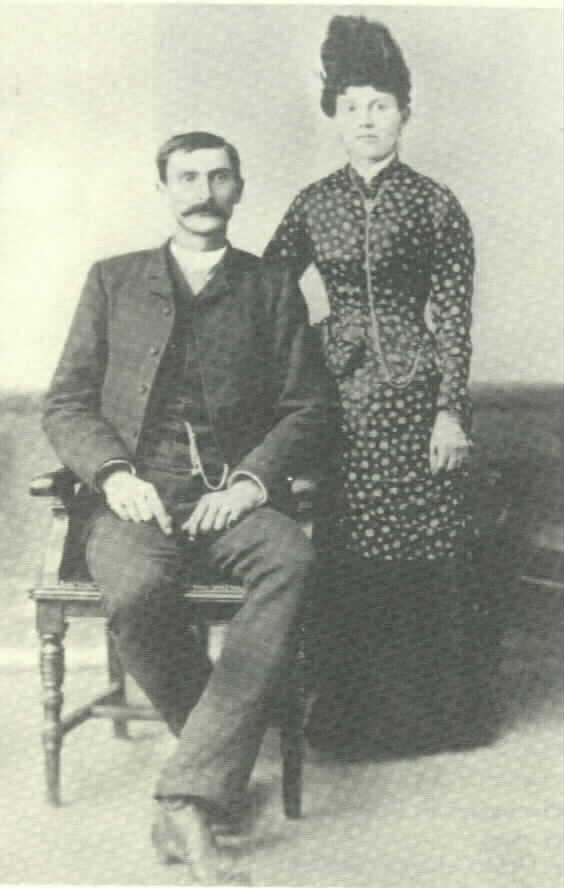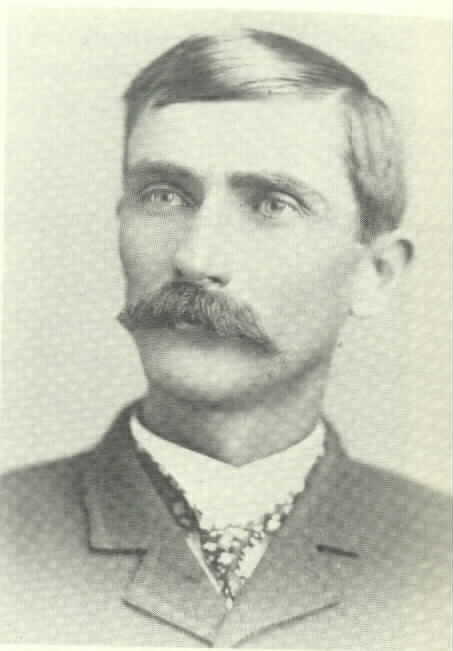
Pat Garrett, with wife Apolonaria
The above photo was taken shortly after the couple's wedding in January 1880.
Patrick Floyd Jarvis Garrett was born on June 5, 1850 in Chambers County, Alabama, the eldest child of John and Elizabeth Garrett. A couple years later, the family moved to Claiborne Parish, Louisiana. Although the family owned a prosperous plantation throughout the 1850s, the Civil War caused them to lose it all and fall into debt. As a child, Pat did chores around the plantation and attended school, but allegedly quit formal education early on due to the fact that his long legs could no longer fit under the classroom's desks. By early 1868, both of Pat's parents had died and he hit the trail, becoming a trail drive in Texas. He quickly became an adept buffalo hunter in the area around Fort Griffin. In Nov. 1876, Pat made a derogatory comment about fellow hunter Joe Briscoe's Irish heritage, something Briscoe took offense to. Briscoe attacked Pat, but due to Pat's great advantage in size, he easily bested the Irishman. Further angered, Briscoe attacked Pat again, this time with an ax. Pat quickly pulled his pistol and killed Briscoe. No charges were filed for the self-defense killing. Around Feb. 1878, Pat had given up life as a buffalo hunter and traveled to Fort Sumner, in San Miguel County, New Mexico. There, he got a job working as cowboy on Pete Maxwell's ranch, but was soon fired for allegedly stealing his employer's cattle. Thereafter, Pat got a job working as a bartender at the Sumner saloon of Beaver Smith. He also started up a hog ranch of his own around Sumner at this time. At some point, he married a Juanita Martinez, who died shortly after their marriage. In the late summer of 1878, Billy the Kid and the Regulators fled to Fort Sumner following the close of the Lincoln County War. Pat, still working as Smith's bartender, became friendly with the Regulators and, allegedly, Billy in particular, the two gambling and attending bailes together. On Jan. 14, 1880, Pat married again, this time to Apolonaria Gutierrez. Pat's friend (and a member of Billy the Kid's new gang of rustlers) Barney Mason also was married on this same day, and the weddings were held together at Anton Chico. His marriage to Apolonaria would yield eight children. The friendship between Pat and the Kid came to an end however, in the fall of 1880, when Pat, under the advice of John Chisum and Joseph Lea, moved to Roswell, in Lincoln County, so that he could run for sheriff in the next election. Pat won the election, beating incumbent George Kimbrell, and was made deputy in Nov. 1880. Under dubious means, he was also appointed as a deputy U. S. marshal, giving him authority to pursue criminals over county lines. Pat immediately set to work going after Billy and the Rustlers. A massive manhunt began, with cowboys from Texas ranches and Special Agent Azariah Wild of the U. S. Treasury Department (who was investigating allegations of counterfeit money being passed in Lincoln County) joining Pat in the chase. Early in the pursuit, Pat managed to arrest gang member Joe Cook and escaped prisoners from Las Vegas, J. J. Webb and George Davis, but otherwise, turned up nothing. In mid-Dec., Pat and his deputy, former Rustler-turned-informant, Barney Mason, joined forces with Frank Stewart, a cattle detective from the Canadian River Cattlemen's Association in Texas, and a band of six cowboys. On evening of Dec. 19, 1880, Pat and his posse ambushed the Rustlers at Fort Sumner, killing gang member Tom Folliard and Dave Rudabaugh's horse in the process. A few days later, on Dec. 23, the posse tracked the remaining Rustlers to a rock house at Stinking Springs. Another gunfight ensued, with Pat's posse killing gang member Charlie Bowdre before the rest of the gang, Billy, Rudabaugh, Tom Pickett, and Billy Wilson, surrendered. Afterward, Pat took the four outlaws to Las Vegas, where he stood off a lynch mob intent on taking Rudabaugh, then to Santa Fe. While the outlaws had their trials, Pat returned to Lincoln. After Billy was convicted of the murder of Sheriff William Brady and sentenced to hang, he was handed over to Pat and kept in the town's courthouse. While Pat was in White Oaks on Apr. 28, 1881, Billy managed to escape, killing guards J. W. Bell and Bob Olinger in the process. Pat initially expected that the Kid would have fled to Mexico and made no serious attempt to recapture him. However, rumors persisted the Kid returned to Fort Sumner, forcing Pat to investigate. On the evening of July 14, Pat and deputies John Poe and Thomas McKinney rode into Sumner, but were initially unable to locate the Kid. Pat then visited the house of Pete Maxwell, when (according to Pat and Poe) the Kid coincidentally walked into the same darkened room. Claiming he recognized his voice, Pat drew his pistol and shot the Kid, killing him instantly. Following this, Pat became a celebrity. He was awarded large sums of money from private citizens and, through some difficulty, managed to obtain the official reward of $500 in Feb. 1882. Also in 1882, he had a friend of his, Marshall Ashmun Upson, ghost-write a book for him entitled "An Authentic Life of Billy the Kid." The book, however, was a failure. In late 1882, Pat decided against running again for sheriff and instead backed Jimmy Dolan, who lost the election to John Poe. In 1884, after failed attempts at ranching around Fort Stanton and the Rio Hondo, Garrett moved to the Panhandle, where he hunted horse thieves for the LS Ranch. He soon after returned to New Mexico and his next venture, a plan to irrigate the Pecos Valley, was another failure. In 1889, he ran for sheriff of the newly-formed Chaves County, but lost there as well, to a rancher named Campbell Fountain, who was backed by Garrett's former deputy, John Poe. Embarrassed, Garrett moved to Uvalde, Texas in 1891, where he started a horse ranch. He returned once again to New Mexico, this time to Dona Ana County, in early 1896, after he was hired to solve the Feb. 1 disappearance of Col. Albert J. Fountain. While working on the case, he was appointed a deputy and in late Apr. 1896, the current sheriff resigned, thereby making Garrett a sheriff once again. Although his investigation managed to bring charges against a few men for Fountain's murder, no one was ever convicted and the case was never closed. While he was still a sheriff, Garrett was involved in another shootout in Oct. 1899, in which he or a deputy killed an Oklahoma fugitive named Billy Reed/Norman Newman. Pat was appointed collector of customs at El Paso by President Theodore Roosevelt in 1901, but his term was not renewed for the next term in 1903. Later, he once again turned to ranching in Dona Ana County, although by this time he had developed a drinking and gambling problem, was in deep debt, and was occasionally staying with a prostitute. He ended up leasing some of his land to Jesse Wayne Brazel, but a disagreement soon arose between the two. On Feb. 29, 1908, while Pat was riding a buggy from his ranch to Las Cruces, he was shot in the head and in the stomach and killed. Who exactly pulled the trigger remains a mystery, although Brazel himself took credit for the slaying and went to trial, only to be acquitted on grounds of self-defense. Others who have been theorized to have really killed Garrett are Carl Adamson, who was riding with Garrett to Las Cruces; Jim Miller, a killer-for-hire who was notorious in his own right; and Yginio Salazar, a friend of Billy the Kid who may have killed him out of revenge for the Kid. Still, another theory is that he was killed by the same men who killed Col. Fountain. The truth will probably never be known.

Sheriff Pat Garrett
This photo of Garrett was taken in Las Vegas in 1881, after he began to gain notoriety as the famous "killer of Billy the Kid."

Pat Garrett
This photo was taken in the winter of 1887 near Roswell. This depicts Pat as he would have appeared while tracking the Rustlers in the winter of 1880.